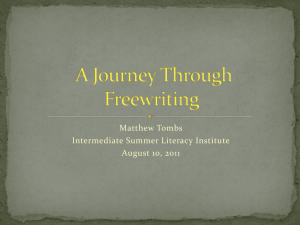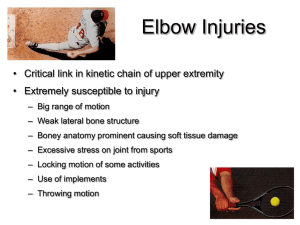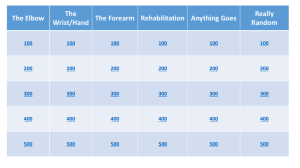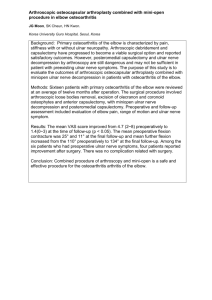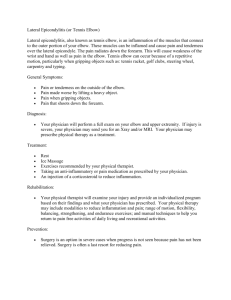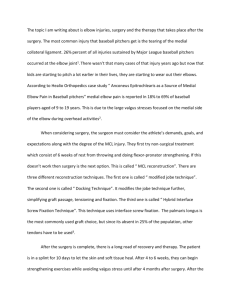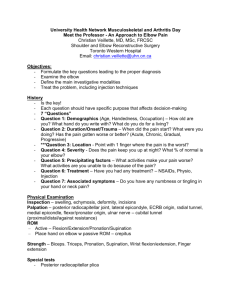The American Journal of Sports Medicine Aged Baseball
advertisement
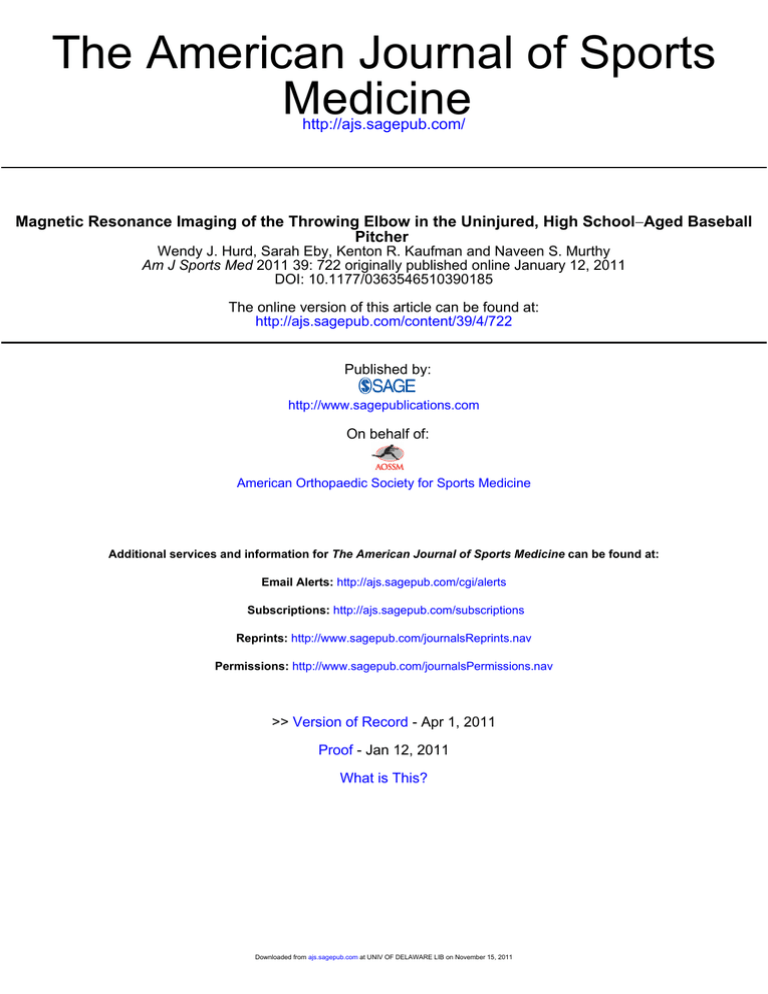
The American Journal of Sports Medicine http://ajs.sagepub.com/ Magnetic Resonance Imaging of the Throwing Elbow in the Uninjured, High School−Aged Baseball Pitcher Wendy J. Hurd, Sarah Eby, Kenton R. Kaufman and Naveen S. Murthy Am J Sports Med 2011 39: 722 originally published online January 12, 2011 DOI: 10.1177/0363546510390185 The online version of this article can be found at: http://ajs.sagepub.com/content/39/4/722 Published by: http://www.sagepublications.com On behalf of: American Orthopaedic Society for Sports Medicine Additional services and information for The American Journal of Sports Medicine can be found at: Email Alerts: http://ajs.sagepub.com/cgi/alerts Subscriptions: http://ajs.sagepub.com/subscriptions Reprints: http://www.sagepub.com/journalsReprints.nav Permissions: http://www.sagepub.com/journalsPermissions.nav >> Version of Record - Apr 1, 2011 Proof - Jan 12, 2011 What is This? Downloaded from ajs.sagepub.com at UNIV OF DELAWARE LIB on November 15, 2011 Magnetic Resonance Imaging of the Throwing Elbow in the Uninjured, High School–Aged Baseball Pitcher Wendy J. Hurd,*y PT, PhD, SCS, Sarah Eby,y Kenton R. Kaufman,y PE, PhD, and Naveen S. Murthy,y MD Investigation performed at the Mayo Clinic, Rochester, Minnesota Background: Tissue adaptations in response to pitching are an expected finding during magnetic resonance imaging (MRI) evaluation of the throwing elbow of adult pitchers. These changes are considered normal in the absence of symptom complaints. It is unclear when during the playing career these tissue adaptations are initiated. Hypothesis: Abnormalities in the appearance of the throwing elbow compared with the nonthrowing elbow would be visible during MRI assessment of this asymptomatic population of high school–aged throwers. Study Design: Cross-sectional study; Level of evidence, 3. Methods: Twenty-three uninjured, asymptomatic male high school–aged baseball pitchers (mean age, 16 years) with no history of elbow injury were recruited for the study. Participants had a minimum of 3 years’ experience with pitching as their primary position (mean experience, 6 years). Bilateral elbow MRI examinations were performed using a standardized protocol including fast spin-echo proton-density (axial and coronal), T1-weighted (sagittal), and T2-weighted fat-saturated (axial, sagittal, and coronal) sequences. Osteoarticular, ligamentous, musculotendinous, and neural structures were evaluated and compared bilaterally. The images were reviewed by a musculoskeletal radiologist who was blinded to all the gathered data on these athletes, including limb dominance. Results: Three participants (13%) had no abnormalities. Fifteen individuals (65%) had asymmetrical anterior band ulnar collateral ligament thickening, including 4 individuals who also had mild sublime tubercle/anteromedial facet edema. Fourteen participants (61%) had posteromedial subchondral sclerosis of the ulnotrochlear articulation, including 8 (35%) with a posteromedial ulnotrochlear osteophyte, and 4 (17%) with mild posteromedial ulnotrochlear chondromalacia. Ten individuals (43%) had multiple abnormal findings in the throwing elbow. Conclusion: Thickening of the anterior band of the ulnar collateral ligament and posteromedial subchondral sclerosis of the trochlea are common findings in the high school–aged pitcher and may be considered normal clinical findings in the absence of symptom complaints. Other changes in tissue appearance of the throwing elbow are uncommon in this age group and should be regarded with a higher level of caution when evaluating for the presence of injury. An understanding of the MRI appearance of the uninjured youth pitcher is necessary for clinicians to distinguish between normal adaptations and the presence of injury. Keywords: overhead athlete; MRI; ulnar collateral ligament pitchers.9 The high school–aged pitcher is vulnerable to a range of injuries including ulnar collateral ligament (UCL) tears, medial epicondylitis, ulnar neuritis, apophysitis, osteochondral lesions, valgus extension overload, and posterolateral instability.12 The cause of the majority of these injuries may be traced to the nature of the overhead pitching motion, which repetitively exposes the upper extremity to tremendous forces. The resulting accumulation of microtrauma can manifest as chronic upper extremity injury in the overhead athlete. Magnetic resonance imaging has proven to be an integral clinical imaging tool used in the assessment and diagnosis of elbow injury.6,7,10 However, anatomic changes in the throwing limb of the overhead athlete do not always correlate with symptom complaints. Osseous and soft tissue changes of both the shoulder and elbow have been described in uninjured, skeletally mature pitchers. These Although high school baseball is generally considered fairly safe, injuries are not uncommon in this population. The upper extremity is the anatomic region most often involved in baseball-related injuries,14 with the elbow cited as a source of throwing-related pain in 26% of youth *Address correspondence to Wendy J. Hurd, PT, PhD, SCS, Charlton North Building, L110, Rochester, MN 55902 (e-mail: hurd.wendy@ mayo.edu). y Mayo Clinic, Rochester, Minnesota. One or more of the authors has declared the following potential conflict of interest or source of funding: Funding for this study was provided by the Kelly-Aircast Foundation, and Dr Hurd’s salary support was provided by the National Institutes of Health (T-32 HD00447). The American Journal of Sports Medicine, Vol. 39, No. 4 DOI: 10.1177/0363546510390185 Ó 2011 The Author(s) 722 Downloaded from ajs.sagepub.com at UNIV OF DELAWARE LIB on November 15, 2011 Vol. 39, No. 4, 2011 MRI of the Elbow in Pitchers findings are considered normal adaptations in response to the stress of throwing in the absence of symptom complaints.5,6,10,11,19 Thus, defining the normal imaging appearance has been considered advantageous as this information may be useful for clinicians in determining appropriate treatment interventions.6 Little is known, however, regarding the normal appearance of the elbow among youth athletes. One study has described the appearance of the elbow in uninjured youth pitchers during MRI evaluation.5 This study, however, included athletes who represented a skeletally diverse age range (12 to 18 years). Additionally, only the appearance of the UCL was evaluated. Thus, it is difficult to make strong conclusions from this investigation regarding expected findings compared with pathologic findings during MRI assessment of elbow injuries in the high school–aged baseball pitcher. It is unclear at this time whether the cumulative microtrauma associated with throwing that manifests as tissue adaptations in the mature thrower are present in the youth pitcher. Defining the normal appearance of the uninjured youth baseball pitcher’s elbow during MRI evaluation is necessary to assist with correct injury diagnosis and to assist in the clinical decision-making process. Therefore, the purpose of this study was to document the elbow MRI findings of the uninjured, asymptomatic high school–aged pitcher. We hypothesized that abnormalities in the appearance of the throwing elbow compared with the nonthrowing elbow would be visible during MRI assessment of this asymptomatic population of youth throwers. MATERIALS AND METHODS Participants Twenty-three uninjured, asymptomatic male high-school pitchers participated in the study. Demographics for the sample included a mean age of 16 years (range, 15-19 years), weight 79.8 kg (range, 56.7-97.5 kg), height 1.8 m (range, 1.61.9 m), and 6 years of experience as a pitcher (range, 3-10 years). There were 17 right-hand–dominant pitchers and 6 left-hand–dominant pitchers in the sample. To be eligible for study participation, candidates were required to have a minimum of 3 years of consecutive experience with pitching as their primary position, to be between 14 and 19 years old, and to be unrestricted in baseball activities. Individuals were not eligible for participation in the study if they had a current injury to either upper extremity or a history of elbow injury in either extremity or did not meet all eligibility criteria. Unrestricted sports participation was confirmed with a QuickDash Sports score of 10%. Absence of upper extremity injury was confirmed by a physical examination conducted by a board-certified sports physical therapist (W.J.H.). Components of the examination included assessment of elbow pain, tenderness to palpation, neurovascular integrity, medial elbow stability, and valgus-extension overload. Participant consent and parental assent was obtained before initiating testing procedures, which were approved by the Mayo Clinic Institutional Review Board. 723 Procedures Image acquisition was performed using a 1.5-T magnetic resonance unit (GE Healthcare, Milwaukee, Wisconsin) with a dedicated, institutionally developed birdcage extremity surface coil. Bilateral images of the elbow were obtained in axial (slice thickness 4 mm/spacing 0.5 mm), sagittal (slice thickness 3 mm/spacing 0.5 mm), and coronal planes (slice thickness 3 mm/spacing 0.5 mm), utilizing fast spin-echo proton-density (axial and coronal), T1-weighted (sagittal), and T2-weighted fat-saturated (axial, sagittal, and coronal) sequences. During testing, participants were prone with their arm positioned above their head, keeping the elbow in the isocenter of the magnet. Images were evaluated for osteoarticular abnormalities including chondromalacia, bone marrow edema, osteophytes, subchondral sclerosis, growth-plate status, and loose bodies; ligament evaluation included assessment of asymmetric thickening, signal heterogeneity, discontinuity, and bony avulsion; muscle/tendon structures were evaluated for thickening, edema, tendinosis, and discontinuity; and the ulnar nerve was evaluated for edema and thickening.6 All images were read by the same boardcertified, fellowship-trained, musculoskeletal radiologist (N.S.M.) who was blinded to all participant data including the throwing limb. RESULTS Growth-plate assessment indicated all participants had achieved skeletal maturity for the elbow complex. Three athletes (13%) had no abnormal signal or asymmetry noted during evaluation. There were no changes in morphologic asymmetry of the radial collateral ligament complex, and none of the participants exhibited changes in caliber or signal intensity of the ulnar nerve. A small elbow joint effusion was noted in 4 of 23 participants (17%). In each case, a small joint effusion was also present in the contralateral elbow. One athlete was noted to have heterogeneous increased T2-weighted signal intensity in the musculotendinous insertion of the triceps in the dominant arm, and one in the extensor-mass origin of the nondominant arm. Otherwise, there was no asymmetric morphologic or signal changes for the muscle/tendon units evaluated (Table 1). Asymmetric thickening of the anterior band of the UCL of the dominant limb was noted in 15 of 23 participants (65%) (Figure 1) (Table 1). Mild bone marrow edema of the sublime tubercle accompanied the morphologically abnormal appearance of the UCL in 3 of these individuals (Figure 2). No participants had signal heterogeneity or ligament discontinuity. In 1 participant, the presence of UCL thickening was present bilaterally, and there was 1 participant with thickening of the UCL on the nondominant limb only. Osteoarticular tissue changes were observed. Fourteen participants (61%) had posteromedial subchondral sclerosis of the ulnotrochlear articulation in the throwing elbow (Figure 3) (Table 1). In 8 of 14 cases, the ulnotrochlear Downloaded from ajs.sagepub.com at UNIV OF DELAWARE LIB on November 15, 2011 724 Hurd et al The American Journal of Sports Medicine TABLE 1 Participant MRI Findingsa Soft Tissue Osteoarticular UCL Muscle/ Joint Ulnar Ulnotrochlear Thickening Tendon Effusion Nerve Chondromalacia Participant 1 2 3 4 5 6 7 8 9 10 11 12 13 14 15 16 17 18 19 20 21 22 23 Age, Pitching y Experience, y 19 16 16 17 17 15 16 17 15 19 18 15 17 16 16 16 15 17 16 15 17 18 16 7 3 5 5 7 6 10 7 6 9 4 3 10 3 8 7 9 5 11 4 6 7 5 D ND D ND D ND D ND D Ulnotrochlear Subchondral Ulnotrochlear Bone Marrow Sclerosis Osteophyte Edema ND D 1 ND D 1 1 1 1 1 1 1 1 1 1 1 1 1 1 D ND 1b 1b 1 1 1 ND 1 1 1 1 1 1 1 1 1 1 1 1 1 1 1 1 1 1 1 1 1 1 1 1c 1 1 1 1 1 1 1 1e 1d 1 1 1f a UCL, ulnar collateral ligament; D, dominant elbow; ND, nondominant elbow; 1, present. Olecranon. c Triceps insertion. d Medial epicondyle. e Extensor mass origin. f Lateral epicondyle and radial head. b subchondral sclerosis was present in the trochlea only, and in 6 of 14 cases sclerosis was present in both the trochlea and ulna. Eight individuals (35%) had small posteromedial ulnotrochlear osteophytes, all of which were located at the olecranon (Figure 3) (Table 1). Mild posteromedial ulnotrochlear articulation chondromalacia was noted in 4 athletes (17%) (Table 1). Abnormal bone marrow edema was noted bilaterally in the olecranon (dominant, mild; nondominant, moderate) for 1 individual. Two participants exhibited unilateral changes of bone marrow edema on the nondominant extremity, including mild edema of the medial epicondyle in 1 individual, and moderate edema of the lateral epicondyle and radial head in the second individual (Table 1). Ten individuals had multiple, asymmetric adaptations in the throwing elbow (Table 1). Ten of the 15 individuals with UCL thickening also exhibited posteromedial ulnotrochlear subchondral sclerosis. Eight of the 14 individuals with posteromedial ulnotrochlear subchondral sclerosis also had a posteromedial osteophyte. All 4 individuals with chondromalacia of the posteromedial ulnotrochlear articulation had UCL thickening, subchondral sclerosis, and a posteromedial osteophyte (Table 1). DISCUSSION The results of this study indicate the majority of asymptomatic high school–aged pitchers have some form of radiographic abnormality or asymmetry of the throwing elbow during MRI evaluation. Only 3 individuals in this sample (13%) did not have an abnormality in either elbow. Asymmetric anterior band UCL thickening (65%) and posteromedial ulnotrochlear subchondral sclerosis (61%) of the throwing elbow were the most common findings. Other abnormal findings or changes in anatomic appearance were less common. There were no changes noted in the radial collateral ligament complex, and only 1 individual had T2-weighted signal changes compatible with tendinopathy in the triceps tendon attachment in the throwing elbow. Other findings that were present bilaterally or only Downloaded from ajs.sagepub.com at UNIV OF DELAWARE LIB on November 15, 2011 Vol. 39, No. 4, 2011 MRI of the Elbow in Pitchers 725 Figure 1. A, thickened anterior band of the ulnar collateral ligament in the dominant, throwing right arm (arrows). B, normal MRI appearance of the anterior band of the ulnar collateral ligament in the nondominant, nonthrowing left arm of the same participant (arrows). Figure 2. A, thickened anterior band of the ulnar collateral ligament in the dominant, throwing right arm (arrows). Mild sublime tubercle bone marrow edema (arrowhead). B, normal MRI appearance of the anterior band of the ulnar collateral ligament in the nondominant, nonthrowing left arm of the same participant (arrows). No sublime tubercle bone marrow edema (arrowhead). in the nonthrowing elbow, such as joint effusion and bonemarrow edema, were not considered a response to throwing. The presence of UCL thickening is likely related to joint forces experienced during pitching. During arm acceleration, the medial elbow is exposed to an external valgus torque as the elbow rapidly extends. The valgus load has been estimated to stress the UCL near its maximum tensile capacity.18 Thickening of the UCL may consequently be interpreted as a soft tissue adaptation in response to this stress. The results of the current investigation indicate asymmetric thickening of the UCL in the dominant elbow is a common finding in asymptomatic youth pitchers. The rate of abnormal UCL presentation in the current investigation, however, contrasts with a previous study assessing the elbow appearance of asymptomatic youth pitchers. Jazrawi et al5 gathered T1- and T2-weighted coronal and Downloaded from ajs.sagepub.com at UNIV OF DELAWARE LIB on November 15, 2011 726 Hurd et al The American Journal of Sports Medicine Figure 3. A, subchondral sclerosis of the posteromedial ulnotrochlear articulation in the dominant, throwing right arm (arrows). Associated tiny osteophyte formation along the posteromedial ulnotrochlear articulation (arrowhead). B, normal MRI appearance of the ulnotrochlear articulation of the nondominant, nonthrowing left arm of the same participant. No osteophyte formation along the posteromedial ulnotrochlear articulation. axial images of the elbow in 14 pitchers using a 1.5-T Sigma MRI unit (GE Healthcare). Participants in the study were between 12 and 18 years of age, had an average of 6.5 years’ pitching experience, were asymptomatic at the time of testing, and had no history of elbow injury. Images for the right and left elbows were read at different times, and the UCL appearance was graded based on both signal intensity and morphologic appearance. Among this cohort, there were only 4 athletes (28%) who exhibited UCL thickening in the throwing elbow. This finding prompted the authors to conclude the athletes had not participated in pitching activities for an adequate period of time to induce ligament adaptations.5 Methodological differences may explain the discrepancy in the rate of abnormal UCL appearance between studies. In the current investigation, images of each elbow were evaluated individually and subsequently compared bilaterally while the examiner was blinded to limb dominance. This evaluation method, which has been utilized in imaging studies of adult pitchers,6 was chosen based on the difficulty in identifying early-stage, nonpathologic tissue changes. Furthermore, a bilateral comparison is the clinical standard for identifying abnormal presentation during patient evaluation. In our opinion, the contralateral limb for each participant served as the ideal control, facilitating identification of side-to-side differences occurring as a response to throwing. Thus, we believe the current study was able to identify early-stage UCL changes that may not have been identified in the study by Jazrawi et al.5 Changes in the UCL described in the current investigation of asymptomatic youth pitchers are consistent with findings in adults. Imaging studies of uninjured, asymptomatic professional pitchers have described unilateral abnormalities in UCL appearance including thickening, signal heterogeneity, and discontinuity.6,11,12 Kooima et al6 collected bilateral elbow magnetic resonance images in 16 asymptomatic professional pitchers. The authors reported UCL abnormalities (defined as thickening, discontinuity, or signal heterogeneity) in the dominant elbow in 14 of the 16 (87%) pitchers. Kooima et al6 emphasized many of the findings were subtle and became more evident when the contralateral elbow was used as a comparison. Nazarian et al11 performed bilateral evaluation of the UCL in 26 asymptomatic Major League Baseball pitchers using ultrasonography. Nazarian et al11 reported the anterior band of the UCL, the primary stabilizer against elbow valgus stress, was on average 1 mm thicker on the throwing arm compared with the nonthrowing arm. Results from the current investigation indicate that the changes in UCL appearance observed in adult pitchers are initiated early in the playing career. Edema of the sublime tubercle/anteromedial facet was noted in a subgroup of individuals with UCL thickening. This finding is consistent with an osseous stress reaction, suggesting these individuals may be at increased risk for future injury or perhaps be more likely to experience medial elbow symptoms. Distal involvement of the UCL, however, is not common. The anatomic area of injury to Downloaded from ajs.sagepub.com at UNIV OF DELAWARE LIB on November 15, 2011 Vol. 39, No. 4, 2011 MRI of the Elbow in Pitchers this ligament has been documented and most frequently presents as a midsubstance tear. Glajchen et al4 first described avulsion fracture of the sublime tubercle, a small protuberance on the medial aspect of the coronoid process of the ulna that serves as the distal attachment of the anterior band of the UCL, in a series of 3 throwing athletes with symptomatic medial elbow pain. Conway et al3 reported the results of 70 patients who had undergone either repair or reconstruction of the UCL. Only 7 had soft tissue avulsion of the ulnar attachment. Savoie et al17 described outcomes of surgical repair of the UCL in 60 patients under the age of 23 years, noting a distal repair of the ligament was necessary in 11 patients, proximal repair in 40 patients, and 9 required both proximal and distal repair. Petty et al13 described clinical results and injury risk factors based on data collected from 27 former high school pitchers who had undergone UCL reconstruction. Sublime tubercle fracture or avulsion was noted in the radiographic findings in 6 of the patients. Although less common than midsubstance involvement, an avulsion fracture involving the ulnar attachment of the UCL is significant. Nonoperative management of these injuries is rarely successful.16 Thus, early recognition of this condition has been advocated in an effort to avoid surgical intervention. Future studies will be necessary to determine if anteromedial facet bone marrow edema is a precursor to a more serious injury involving the UCL. Results from this study indicate the degenerative process associated with valgus extension overload is initiated at a young age. Unilateral, posteromedial ulnotrochlear subchondral sclerosis was a common finding among the participants in this study, as was the combination of subchondral sclerosis and posteromedial osteophyte formation of the ulnotrochlear articulation. These changes may be attributed to the rapid elbow extension that occurs during pitching in conjunction with valgus torque of the elbow, which promotes abutment of the medial olecranon tip against the medial wall of the olecranon fossa.18 In adults, the presence of posteromedial osteophytes or subchondral sclerosis6 has been used during imaging evaluation to confirm pathologic valgus-extension overload. These findings are also common, however, in asymptomatic athletes, as Kooima et al6 reported 81% of asymptomatic adult pitchers had 1 or both of these findings during MRI evaluation. A significant portion of the participants in the current investigation (43%) had multiple adaptations in their throwing elbow. The most common combinations of abnormal findings included UCL thickening in conjunction with posteromedial ulnotrochlear subchondral sclerosis, and posteromedial ulnotrochlear subchondral sclerosis with osteophyte formation and/or chondromalacia. The presence of multiple MRI findings at such a young age is concerning, as it indicates more pronounced anatomic changes in response to throwing. These combinations of abnormal findings are also consistent with pathologic findings in mature pitchers. A number of adult throwers who undergo resection of posterior olecranon osteophytes to address valgus-extension overload later require surgical UCL reconstruction, with an initial ligamentous laxity contributing to the formation of the osteophyte.1,2,8 Thus, it is 727 possible this subgroup of asymptomatic high-school pitchers who have multiple abnormal MRI findings may be at greater risk for subsequent elbow injury. This hypothesis, however, must be confirmed with longitudinal follow-up. The consequences of anatomic changes in the high school–aged pitcher’s elbow cannot be determined at this time. It is apparent that many of the changes in tissue appearance are a response to repetitive joint stress experienced during pitching. The current investigation as well as previous studies5,6,11,19 have, however, utilized crosssectional study designs. Consequently, it is unclear if the findings represent variations of normal anatomy, beneficial adaptations, precursor of future symptomatic disease, or a combination of these possibilities.15 The predictive ability of imaging findings in asymptomatic individuals in determining who may go on to sustain injury may only be accomplished with a prospective, longitudinal study. At this time, the most appropriate use of MRI is to consider that there is a high incidence of tissue changes in the youth player, and that any imaging findings must be considered in conjunction with symptom complaints and patient history to develop an effective treatment intervention. This study does have limitations. A control group of nonthrowers was not included. It is therefore not possible to discern changes in the dominant elbow that are a consequence of throwing and which changes are present in the general population. Most of the changes we reported in the throwing elbow, however, were consistent with the biomechanics of the pitching motion, as well as injury patterns observed in this population. Regardless of the cause of the changes in elbow appearance during MRI evaluation, physicians and radiologists should be aware such asymmetries are common in the asymptomatic youth pitcher. Another limitation was the timing of MRI testing relative to the last pitching performance. It is possible individuals who had pitched with relatively little rest before imaging may have transient changes, such as joint effusion. We do not think this is likely, however, as all of the changes noted during evaluation were chronic rather than acute in nature. Another study limitation was our sample size. While larger than previous investigations describing the appearance of the throwing elbow, much larger data sets are necessary to establish normative population data. CONCLUSION Thickening of the anterior band of the UCL and the presence of posteromedial ulnotrochlear subchondral sclerosis are common MRI findings in the asymptomatic high school–aged pitcher. The managing physician and radiologist should be aware of these potential abnormal findings in a young pitcher’s elbow, and not necessarily assume that these findings are responsible for the patient’s symptoms. Other changes in tissue appearance including ligament, osseous, and articular cartilage structures are less pronounced in this age group. Longitudinal studies will be necessary to determine whether these early ligament adaptations are protective against injury or predictive of athletes who may have an increased injury risk. Downloaded from ajs.sagepub.com at UNIV OF DELAWARE LIB on November 15, 2011 728 Hurd et al The American Journal of Sports Medicine REFERENCES 1. Andrews JR, Timmerman LA. Outcome of elbow surgery in professional baseball players. Am J Sports Med. 1995;23(4):407-413. 2. Azar FM, Andrews JR, Wilk KE, Groh D. Operative treatment of ulnar collateral ligament injuries of the elbow in athletes. Am J Sports Med. 2000;28(1):16-23. 3. Conway JE, Jobe FW, Glousman RE, Pink M. Medial instability of the elbow in throwing athletes. Treatment by repair or reconstruction of the ulnar collateral ligament. J Bone Joint Surg Am. 1992;74(1):67-83. 4. Glajchen N, Schwartz ML, Andrews JR, Gladstone J. Avulsion fracture of the sublime tubercle of the ulna: a newly recognized injury in the throwing athlete. AJR Am J Roentgenol. 1998;170(3):627-628. 5. Jazrawi LM, Leibman M, Mechlin M, et al. Magnetic resonance imaging evaluation of the ulnar collateral ligament in young baseball pitchers less than 18 years of age. Bull Hosp Jt Dis. 2006;63(3-4):105-107. 6. Kooima CL, Anderson K, Craig JV, Teeter DM, van Holsbeeck M. Evidence of subclinical medial collateral ligament injury and posteromedial impingement in professional baseball players. Am J Sports Med. 2004;32(7):1602-1606. 7. Lee GA, Katz SD, Lazarus MD. Elbow valgus stress radiography in an uninjured population. Am J Sports Med. 1998;26(3):425-427. 8. Levin JS, Zheng N, Dugas J, Cain EL, Andrews JR. Posterior olecranon resection and ulnar collateral ligament strain. J Shoulder Elbow Surg. 2004;13(1):66-71. 9. Lyman S, Fleisig GS, Waterbor JW, et al. Longitudinal study of elbow and shoulder pain in youth baseball pitchers. Med Sci Sports Exerc. 2001;33(11):1803-1810. 10. Mirowitz SA, London SL. Ulnar collateral ligament injury in baseball pitchers: MR imaging evaluation. Radiology. 1992;185(2):573-576. 11. Nazarian LN, McShane JM, Ciccotti MG, O’Kane PL, Harwood MI. Dynamic US of the anterior band of the ulnar collateral ligament of the elbow in asymptomatic major league baseball pitchers. Radiology. 2003;227(1):149-154. 12. Ouellette H, Bredella M, Labis J, Palmer WE, Torriani M. MR imaging of the elbow in baseball pitchers. Skeletal Radiol. 2008;37(2):115-121. 13. Petty DH, Andrews JR, Fleisig GS, Cain EL. Ulnar collateral ligament reconstruction in high school baseball players: clinical results and injury risk factors. Am J Sports Med. 2004;32(5):1158-1164. 14. Rechel JA, Yard EE, Comstock RD. An epidemiologic comparison of high school sports injuries sustained in practice and competition. J Athl Train. 2008;43(2):197-204. 15. Reider B. What is normal? Am J Sports Med. 2004;32(7):1601. 16. Salvo JP, Rizio L 3rd, Zvijac JE, Uribe JW, Hechtman KS. Avulsion fracture of the ulnar sublime tubercle in overhead throwing athletes. Am J Sports Med. 2002;30(3):426-431. 17. Savoie FH 3rd, Trenhaile SW, Roberts J, Field LD, Ramsey JR. Primary repair of ulnar collateral ligament injuries of the elbow in young athletes: a case series of injuries to the proximal and distal ends of the ligament. Am J Sports Med. 2008;36(6):1066-1072. 18. Werner SL, Fleisig GS, Dillman CJ, Andrews JR. Biomechanics of the elbow during baseball pitching. J Orthop Sports Phys Ther. 1993;17(6):274-278. 19. Wright RW, Steger-May K, Klein SE. Radiographic findings in the shoulder and elbow of Major League Baseball pitchers. Am J Sports Med. 2007;35(11):1839-1843. For reprints and permission queries, please visit SAGE’s Web site at http://www.sagepub.com/journalsPermissions.nav Downloaded from ajs.sagepub.com at UNIV OF DELAWARE LIB on November 15, 2011

